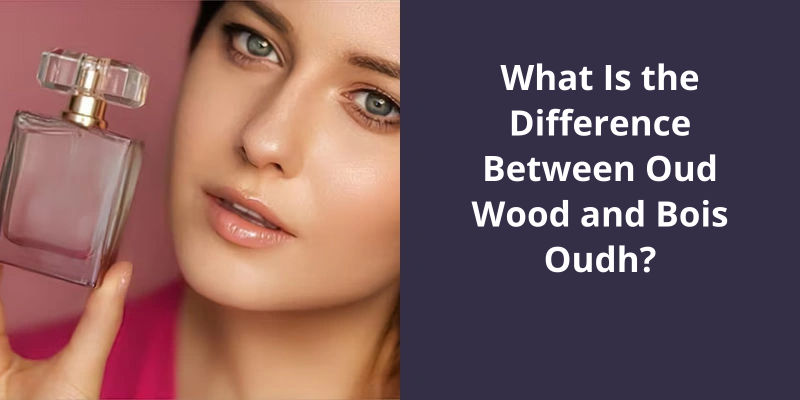The difference between Oud Wood and Bois Oudh lies primarily in their language origins, production, and, sometimes, the scent profiles. Oud Wood, often referred to in western markets, comes from the rare and precious oud resin, associated with warm, woody, and slightly sweet notes. On the other hand, Bois Oudh is a term more commonly used in French-speaking regions for the same oud resin but the scent may differ depending on the formulation. Essentially, they are the same substance extracted from the Agarwood tree but might vary slightly due to their specific blends in perfumery.

What Is the Difference Between Oud and Bakhoor?
Oud is a resinous wood that’s derived from the Aquilaria tree, which is indigenous to the Southeast Asian region. When the tree gets infected naturally by a particular fungus, it starts producing a resinous substance known as agarwood, which is the raw material for producing Oud. The resin builds up in the heartwood of the tree and is extracted from it through various methods such as distillation, hydro-distillation, and steam distillation. There are several grades of Oud, depending on the quality and rarity of the tree. The higher the quality, the higher the price.
Bakhoor, on the other hand, is a traditional Arabic incense that’s burnt to release a fragrant smoke. It’s made by combining various natural ingredients such as sandalwood, musk, rose, and spices, and then mixing them with a binding agent such as honey or plant extracts. The mixture is then shaped into small pellets or sticks that are burnt on an incense burner to release their scent. Bakhoor has a long history in the Arabian Peninsula and is used on many occasions, such as weddings, welcoming guests, and religious ceremonies.
The fragrance of Oud is often described as woody, earthy, and warm. It’s a deep, rich scent that lingers for a long time. Oud is also known for it’s therapeutic properties and is used in traditional medicine to treat many ailments, such as headaches, coughs, and anxiety. Bakhoor, on the other hand, can have a variety of scents, depending on the ingredients used. It can be floral, spicy, musky, or woody. Bakhoor is used mainly for it’s fragrance, but it also has some therapeutic benefits such as reducing stress and enhancing mental clarity.
Oud and Bakhoor are both highly prized in the Middle East and Southeast Asia. They’re considered luxury items and are often given as gifts on special occasions. However, Oud is generally more expensive and is considered the king of fragrances in the Arab world. The rarity and quality of the Oud tree play a significant role in determining it’s price. Bakhoor, on the other hand, is relatively more affordable and is used more frequently in daily life.
But what makes this fragrance so popular? Let’s take a closer look at the history and appeal of oud in the world of fragrances.
Why Is Oud So Popular?
One reason why Oud is so popular is it’s rarity. Oud comes from the wood of the Agarwood tree, which is only found in certain parts of Asia. In order for the wood to produce the Oud fragrance, the tree must become infected with a specific type of mold. This makes the process of harvesting Oud a difficult and time-consuming task.
It can be used as a base note, a heart note, or a top note in perfumes, making it a valuable addition to any fragrance. It pairs well with a variety of other scents, including floral notes, spicy notes, and citrus notes. This allows perfumers to create a wide range of fragrances that appeal to different preferences.
Additionally, Oud has a rich cultural history. It’s been used for centuries in traditional Middle Eastern medicine and is an important part of the regions cultural heritage. As Western culture has become more interested in the Middle East, the popularity of Oud has grown as well. It’s seen as a way to connect with the regions history and traditions.
The complex and captivating scent of Oud also plays a role in it’s popularity. It’s sweet and earthy notes combine with smoky and woody undertones to create a fragrance that’s both sophisticated and sensual. The scent is often described as “mysterious” or “intoxicating,” which only adds to it’s allure.
In addition to it’s potential pain-relieving properties, oud is also known for it’s aromatic and uplifting qualities. It’s been used for centuries in Middle Eastern cultures as a perfume, and it’s popularity has spread worldwide. But the benefits of oud extend beyond it’s pleasing aroma, as it’s believed to have numerous medicinal properties that can promote overall well-being. Let’s delve deeper into the potential benefits of this mystical and ancient scent.
What Are the Benefits of an Oud?
Additionally, oud has been known to have a calming and soothing effect on the mind and body. It’s sweet and woody scent is believed to be helpful in reducing stress and promoting relaxation. In aromatherapy, oud is used to help alleviate anxiety and depression, and to promote overall emotional well-being.
Despite it’s popularity, oud is a rare and expensive ingredient. It’s derived from the resinous wood of the agarwood tree, which is native to Southeast Asia and is often referred to as the “Wood of the Gods”. The tree must be infected with a specific type of fungus in order to produce the resin that’s used to make oud, and this process can take several years. As a result, oud is one of the most expensive fragrance ingredients in the world, and is often referred to as “liquid gold”.
It’s analgesic and anti-inflammatory properties make it a popular treatment for a variety of ailments, including headaches, muscle pain, and respiratory problems. It’s also been used to treat digestive issues, such as nausea and indigestion.
It’s analgesic and anti-inflammatory properties make it beneficial for people suffering from arthritis or other inflammatory conditions, while it’s calming and soothing effects can help to reduce stress and promote relaxation.
How Is Oud Extracted and Processed for Use in Fragrances and Other Products?
Oud is extracted from the agarwood tree by a process called distillation or steam distillation. It’s then processed and mixed with other ingredients before being used in fragrances and other products. The specific process can vary depending on the desired outcome and the manufacturer.
Source: Fragrance Facts: Uses and Benefits of Oud Oil – Parks London
Conclusion
In conclusion, the difference between oud wood and bois oudh lies in their origins and processing methods. Both have distinctive aroma profiles and are highly valued in the fragrance industry.





